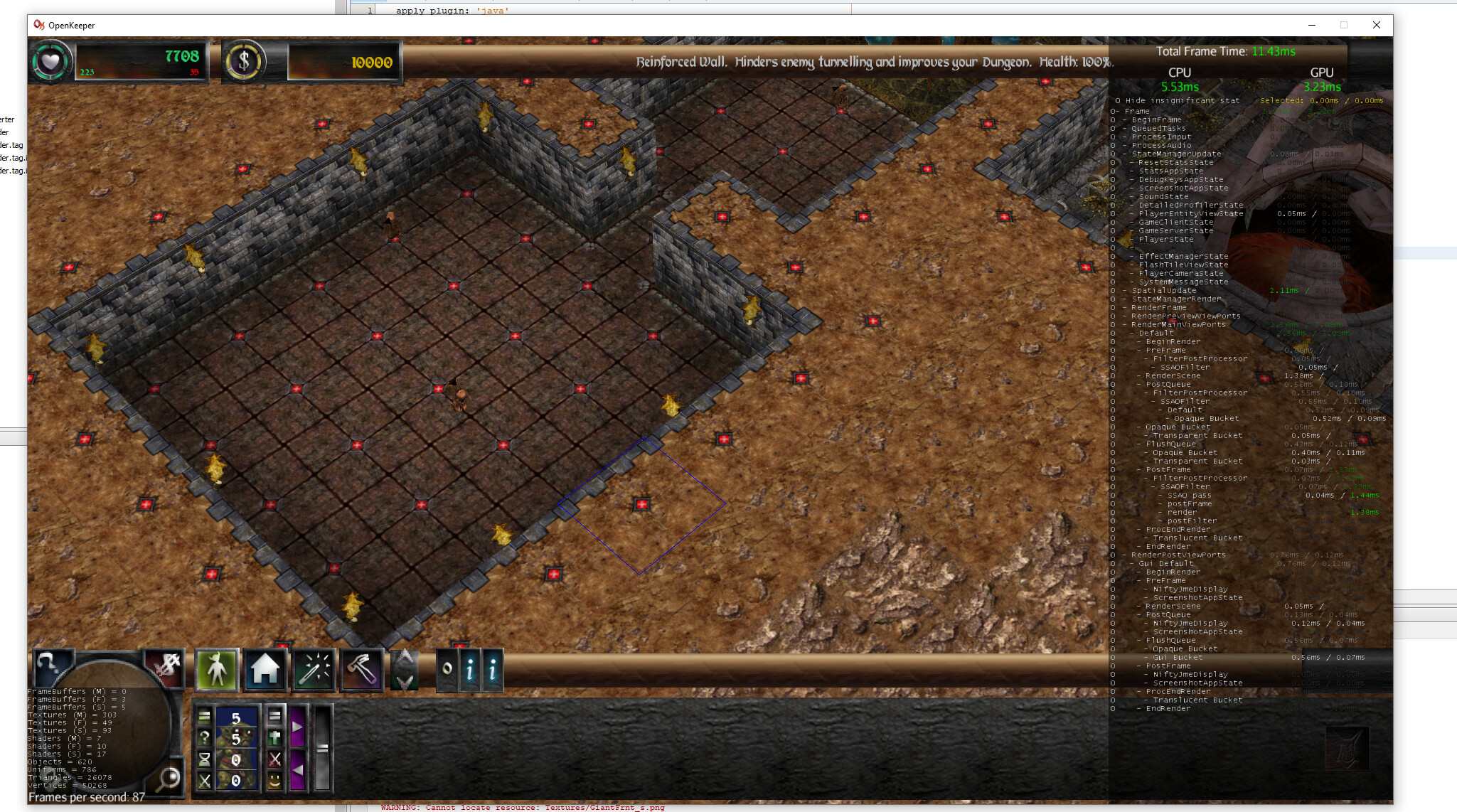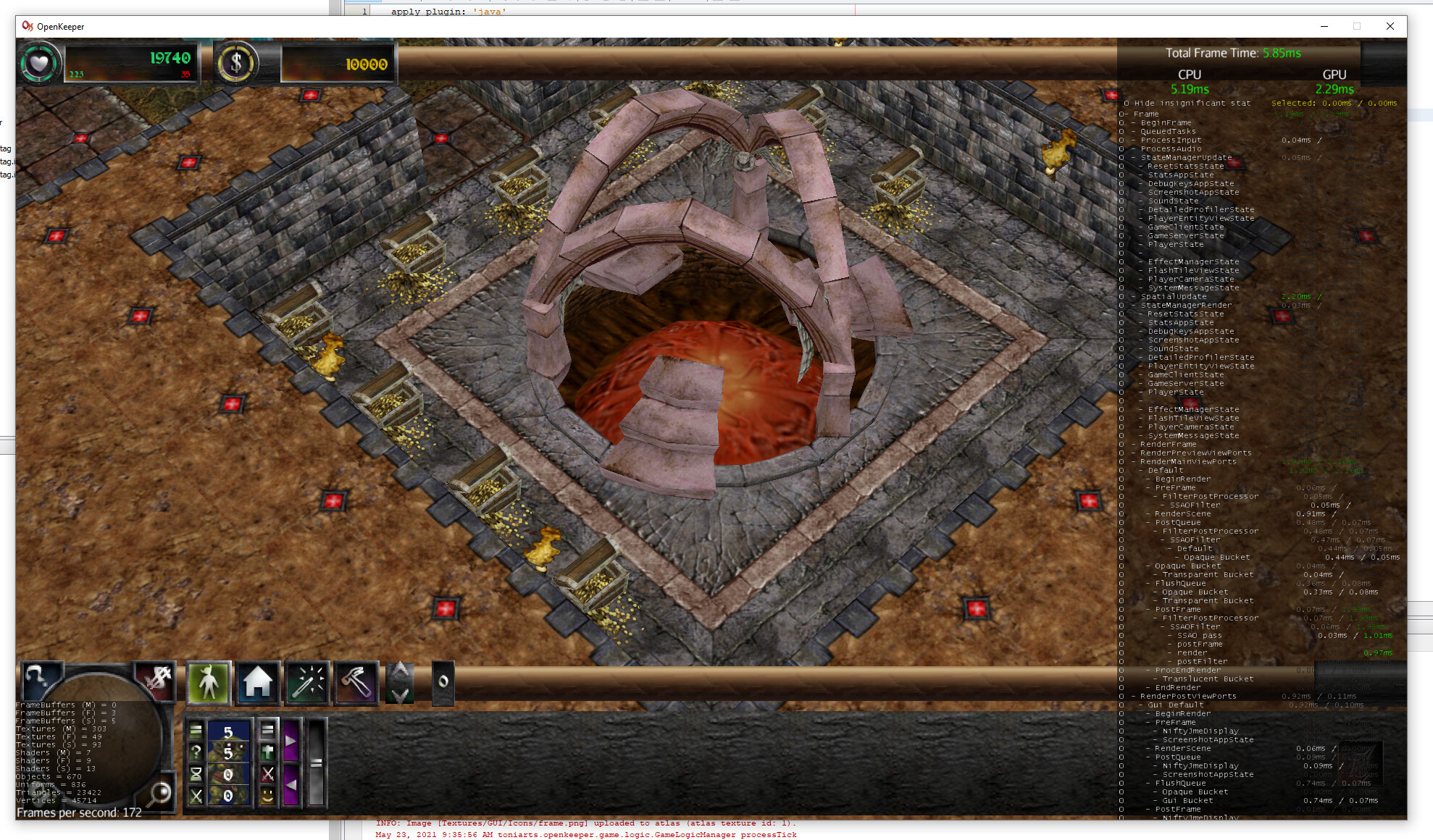Test Issue Physics Terrain
hi everyone,
I was updating some projects to the new version of jmonkey 3.4.0. I have noticed that using the jme3-jbullet libraries, the debug physical form of the terrain is not displayed when physical debugging is enabled. Am I doing something wrong or is there some problem?
below a test case:
/*
* To change this license header, choose License Headers in Project Properties.
* To change this template file, choose Tools | Templates
* and open the template in the editor.
*/
package com.test;
import com.jme3.app.SimpleApplication;
import com.jme3.bullet.BulletAppState;
import com.jme3.bullet.collision.shapes.BoxCollisionShape;
import com.jme3.bullet.collision.shapes.CollisionShape;
import com.jme3.bullet.collision.shapes.HeightfieldCollisionShape;
import com.jme3.bullet.control.RigidBodyControl;
import com.jme3.bullet.util.CollisionShapeFactory;
import com.jme3.light.AmbientLight;
import com.jme3.light.DirectionalLight;
import com.jme3.material.Material;
import com.jme3.math.ColorRGBA;
import com.jme3.math.FastMath;
import com.jme3.math.Vector3f;
import com.jme3.scene.Geometry;
import com.jme3.scene.shape.Box;
import com.jme3.terrain.geomipmap.TerrainLodControl;
import com.jme3.terrain.geomipmap.TerrainQuad;
import com.jme3.terrain.geomipmap.lodcalc.DistanceLodCalculator;
import com.jme3.terrain.heightmap.AbstractHeightMap;
import com.jme3.terrain.heightmap.ImageBasedHeightMap;
import com.jme3.texture.Texture;
/**
*
* @author capdevon
*/
public class Test_IssuePhysicsTerrain extends SimpleApplication {
private BulletAppState physics;
private float grassScale = 64;
private float dirtScale = 16;
private float rockScale = 128;
/**
*
* @param args
*/
public static void main(String[] args) {
Test_IssuePhysicsTerrain app = new Test_IssuePhysicsTerrain();
app.start();
}
@Override
public void simpleInitApp() {
flyCam.setMoveSpeed(25f);
viewPort.setBackgroundColor(new ColorRGBA(0.7f, 0.8f, 1f, 1f));
initPhysics();
initLights();
initTerrain();
cam.setLocation(new Vector3f(0, 10, -10));
cam.lookAtDirection(new Vector3f(0, -1.5f, -1).normalizeLocal(), Vector3f.UNIT_Y);
for (int i = 0; i < 25; i++) {
float halfExtent = 1f;
Box mesh = new Box(halfExtent, halfExtent, halfExtent);
Geometry body = new Geometry("Cube.GeoMesh." + i, mesh);
Material mat = new Material(getAssetManager(), "Common/MatDefs/Misc/Unshaded.j3md");
mat.setColor("Color", ColorRGBA.Red);
body.setMaterial(mat);
body.setLocalTranslation(getRandomSpawnPoint(10, 0));
rootNode.attachChild(body);
BoxCollisionShape collShape = new BoxCollisionShape(new Vector3f(halfExtent, halfExtent, halfExtent));
RigidBodyControl rb = new RigidBodyControl(collShape, 5f);
body.addControl(rb);
physics.getPhysicsSpace().add(rb);
}
}
private Vector3f getRandomSpawnPoint(int radius, int height) {
float x = FastMath.nextRandomInt(-radius, radius);
float z = FastMath.nextRandomInt(-radius, radius);
return new Vector3f(x, height, z);
}
/**
* Initialize the physics simulation
*/
private void initPhysics() {
physics = new BulletAppState();
physics.setDebugEnabled(true);
stateManager.attach(physics);
}
private void initLights() {
DirectionalLight light = new DirectionalLight();
light.setDirection((new Vector3f(-0.5f, -1f, -0.5f)).normalize());
rootNode.addLight(light);
AmbientLight ambient = new AmbientLight();
ambient.setColor(ColorRGBA.White.mult(1.3f));
rootNode.addLight(ambient);
}
private void initTerrain() {
// First, we load up our textures and the heightmap texture for the terrain
// TERRAIN TEXTURE material
Material matRock = new Material(assetManager, "Common/MatDefs/Terrain/Terrain.j3md");
matRock.setBoolean("useTriPlanarMapping", false);
// ALPHA map (for splat textures)
matRock.setTexture("Alpha", assetManager.loadTexture("Textures/Terrain/splat/alphamap.png"));
// HEIGHTMAP image (for the terrain heightmap)
Texture heightMapImage = assetManager.loadTexture("Textures/Terrain/splat/mountains512.png");
// GRASS texture
Texture grass = assetManager.loadTexture("Textures/Terrain/splat/grass.jpg");
grass.setWrap(Texture.WrapMode.Repeat);
matRock.setTexture("Tex1", grass);
matRock.setFloat("Tex1Scale", grassScale);
// DIRT texture
Texture dirt = assetManager.loadTexture("Textures/Terrain/splat/dirt.jpg");
dirt.setWrap(Texture.WrapMode.Repeat);
matRock.setTexture("Tex2", dirt);
matRock.setFloat("Tex2Scale", dirtScale);
// ROCK texture
Texture rock = assetManager.loadTexture("Textures/Terrain/splat/road.jpg");
rock.setWrap(Texture.WrapMode.Repeat);
matRock.setTexture("Tex3", rock);
matRock.setFloat("Tex3Scale", rockScale);
// WIREFRAME material
Material matWire = new Material(assetManager, "Common/MatDefs/Misc/Unshaded.j3md");
matWire.getAdditionalRenderState().setWireframe(true);
matWire.setColor("Color", ColorRGBA.Green);
// CREATE HEIGHTMAP
AbstractHeightMap heightmap = null;
try {
//heightmap = new HillHeightMap(1025, 1000, 50, 100, (byte) 3);
heightmap = new ImageBasedHeightMap(heightMapImage.getImage(), 1f);
heightmap.load();
} catch (Exception e) {
e.printStackTrace();
}
/*
* Here we create the actual terrain. The tiles will be 65x65, and the total size of the
* terrain will be 513x513. It uses the heightmap we created to generate the height values.
*/
/**
* Optimal terrain patch size is 65 (64x64).
* The total size is up to you. At 1025 it ran fine for me (200+FPS), however at
* size=2049, it got really slow. But that is a jump from 2 million to 8 million triangles...
*/
TerrainQuad terrain = new TerrainQuad("terrain", 65, 513, heightmap.getHeightMap());
TerrainLodControl control = new TerrainLodControl(terrain, getCamera());
control.setLodCalculator( new DistanceLodCalculator(65, 2.7f) ); // patch size, and a multiplier
terrain.addControl(control);
terrain.setMaterial(matRock);
terrain.setLocalTranslation(0, -100, 0);
terrain.setLocalScale(2f, 0.5f, 2f);
rootNode.attachChild(terrain);
/**
* We set up collision detection for the scene by creating a compound
* collision shape and a static RigidBodyControl with mass zero.
*/
CollisionShape collShape = CollisionShapeFactory.createMeshShape(terrain);
//CollisionShape collShape = new HeightfieldCollisionShape(terrain.getHeightMap(), terrain.getLocalScale());
/**
* A mesh-accurate shape optimized for static terrains. This shape is
* much faster than other mesh-accurate shapes.
*/
// CollisionShape collShape = new HeightfieldCollisionShape(heightMap.getHeightMap(), terrain.getLocalScale());
RigidBodyControl rgb = new RigidBodyControl(collShape, 0);
terrain.addControl(rgb);
// We attach the scene and the player to the rootnode and the physics space,
// to make them appear in the game world.
physics.getPhysicsSpace().add(terrain);
}
}
the libraries used in the classpath:
gson.jar
j-ogg-all.jar
jbullet.jar
jinput-natives-all.jar
jinput.jar
jme3-core.jar
jme3-desktop.jar
jme3-effects.jar
jme3-jbullet.jar
jme3-jogg.jar
jme3-lwjgl.jar
jme3-niftygui.jar
jme3-plugins.jar
jme3-terrain.jar
jme3-testdata.jar
jmf.jar
jsr305.jar
lwjgl-platform-natives-windows.jar
lwjgl.jar
nifty-default-controls.jar
nifty-examples.jar
nifty-style-black.jar
nifty.jar
stack-alloc.jar
vecmath.jar
xpp3.jar

